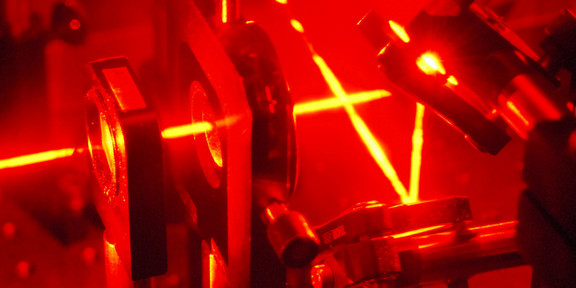Magnetic and Optical Properties of a Two-dimensional Crystal Now under Control
- News
- Research

“In collaboration with our international partners, we have found a new regime of interaction between light and magnetism that promises many exciting results for the future,” says Professor Ilya Akimov from the Department of Physics at TU Dortmund University, who led key studies on magnetization dynamics on the Dortmund side.
To achieve their objective, the scientists first had to systematically “assemble” the new material structure. The starting point for the new structure was a monatomic layer of molybdenum diselenide (MoSe2), which is known for its very strong absorption and emission of light. The aim was to imprint magnetic properties onto this MoSe2 layer: For this purpose, it was attached to an ultrathin europium sulfide (EuS) crystal. The desired magnetic properties were achieved by injecting electrons from the europium sulfide into MoSe2 so that a two-dimensional electron gas formed inside it. The two-dimensional electron gas then became a magnet itself, as it was “spin-polarized” when an external magnetic field was applied.
Strong coupling between light and matter
To make not only the magnetic but also an optical control of the material as efficient as possible, the team had to manipulate the interaction of light with MoSe2 in such a way that all incident light was captured in the material. Although MoSe2 absorbs light very efficiently, it does not absorb it completely. This property was enabled by embedding the material between two mirrors at a precisely controllable distance of less than a millionth of a meter. With this trick, it was possible to achieve what it known as the “regime of strong coupling between light and matter”.
If the system is now illuminated with a laser, each photon of the laser light is captured by shifting one electron per photon into a state of higher energy. This state produced by means of light is called an exciton. The exciton now grabs an electron from the two-dimensional electron gas and forms a new particle known as a trion, which starts to interact with the electron gas magnet. This trion is also magnetic via its spin: The spin can be parallel or antiparallel to the magnetization of the two-dimensional electron gas.
Different interaction
Accordingly, this interaction produces different outcomes: The oscillator strength of the trion, that is, its light-matter coupling, depends on the spin polarization of the electron gas. If the electron gas is fully polarized with spin parallel to the magnetic field, a trion can no longer form because for this it would need an electron with spin antiparallel to the magnetic field: The oscillator strength, that is, the strength of its coupling to light, has dropped to zero for such a trion as a result of the spin polarization.
The conclusions that the team has drawn from this are as follows: The trion shows strong light-matter interaction for parallel orientation, in the anti-parallel case it is cancelled. As a consequence, the reaction to an external magnetic field is five times stronger than for a trion in a simple MoSe2 layer. The researchers were thus able to show that the optical properties of the MoSe2 layer can be precisely controlled by the external magnetic field. Conversely, optical excitation determines the magnetic response: The more trions the laser generates, the more the strength of the light-matter interaction is reduced.
Contact person for inquiries:









